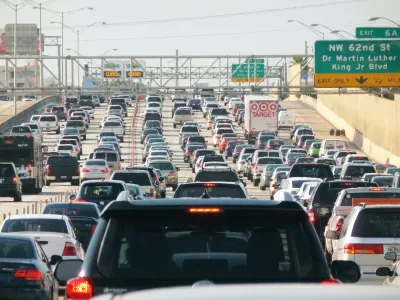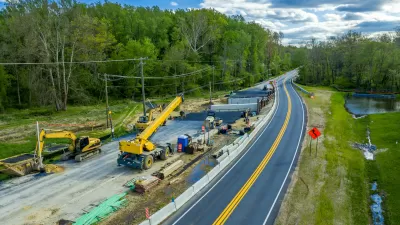The well-documented concept has yet to catch on in state departments of transportation, but acknowledging it could dramatically transform U.S. transportation policy.

Despite frequent and repeated evidence that adding roadway capacity attracts more drivers, Jake Blumgart examines why the concept of induced demand remains a 'hard sell' for many policymakers and transportation professionals.
"Induced demand has been theorized for almost 100 years, formally studied beginning in the 1960s, and quantitatively measured in the 1990s and the early 21st century. This basic concept is key to understanding congestion relief, which is arguably the central policy goal of American transportation planning." Yet the somewhat counterintuitive idea remains "one of the least understood concepts in transportation policy," Blumgart writes, with the consequences apparent in transportation planning and projects across the country.
Blumgart describes how the phenomenon works—essentially, "If the speed of traffic in a given network increases, that prompts people to drive more"— and why it's hard to understand—a combination of intuition and decades of road expansion presented as the solution to traffic, including by transportation engineers. "An entire industry has been built up around endless road expansion and advocacy organizations like the American Society of Civil Engineers are skilled lobbyists for continuing current practices."
Meanwhile, politicians are afraid to reject road expansion proposals and their immediate effects on congestion in favor of long-term planning and unpopular, but effective, alternatives like congestion pricing.
In a future article in the same Governing series, Blumgart will describe how induced demand could change policy in state DOTs.
FULL STORY: Why the Concept of Induced Demand Is a Hard Sell

Planetizen Federal Action Tracker
A weekly monitor of how Trump’s orders and actions are impacting planners and planning in America.

Congressman Proposes Bill to Rename DC Metro “Trump Train”
The Make Autorail Great Again Act would withhold federal funding to the system until the Washington Metropolitan Area Transit Authority (WMATA), rebrands as the Washington Metropolitan Authority for Greater Access (WMAGA).

DARTSpace Platform Streamlines Dallas TOD Application Process
The Dallas transit agency hopes a shorter permitting timeline will boost transit-oriented development around rail stations.

LA County Creating Action Plan to Tackle Extreme Heat
Los Angeles County is creating a Heat Action Plan to help communities stay safe during extreme heat, with steps like adding more shade, improving buildings, and supporting the neighborhoods most at risk.

Maryland Plans Quick-Build Complete Streets Projects
The state will use low-cost interventions to improve road safety in five Maryland counties.

Downtown Los Angeles Gears Up for Growth
A new report highlights Downtown L.A.’s ongoing revival through major housing projects, adaptive reuse, hospitality growth, and preparations for global events in the years ahead.
Urban Design for Planners 1: Software Tools
This six-course series explores essential urban design concepts using open source software and equips planners with the tools they need to participate fully in the urban design process.
Planning for Universal Design
Learn the tools for implementing Universal Design in planning regulations.
City of Charlotte
Municipality of Princeton
Roanoke Valley-Alleghany Regional Commission
City of Camden Redevelopment Agency
City of Astoria
Transportation Research & Education Center (TREC) at Portland State University
US High Speed Rail Association
City of Camden Redevelopment Agency
Municipality of Princeton (NJ)





























